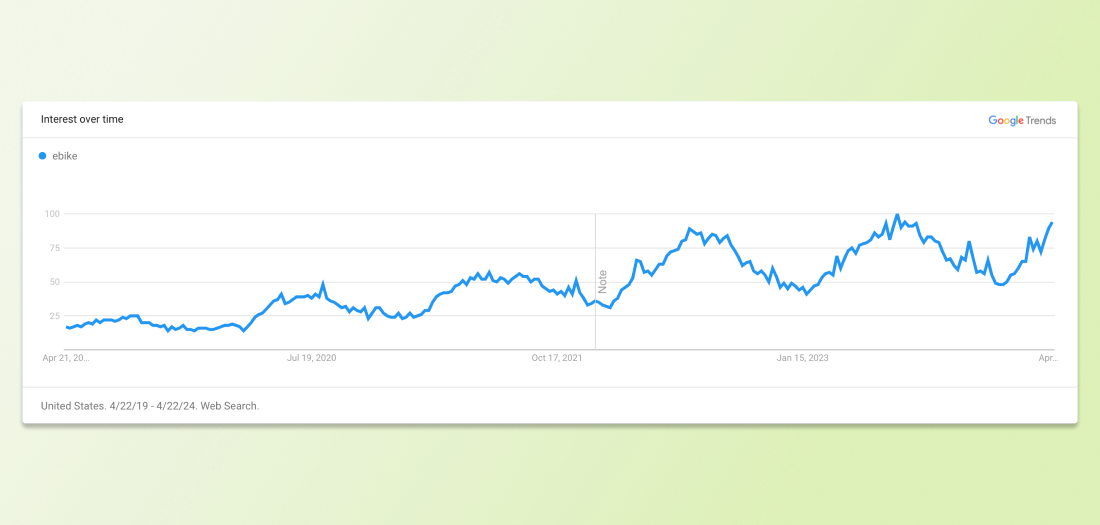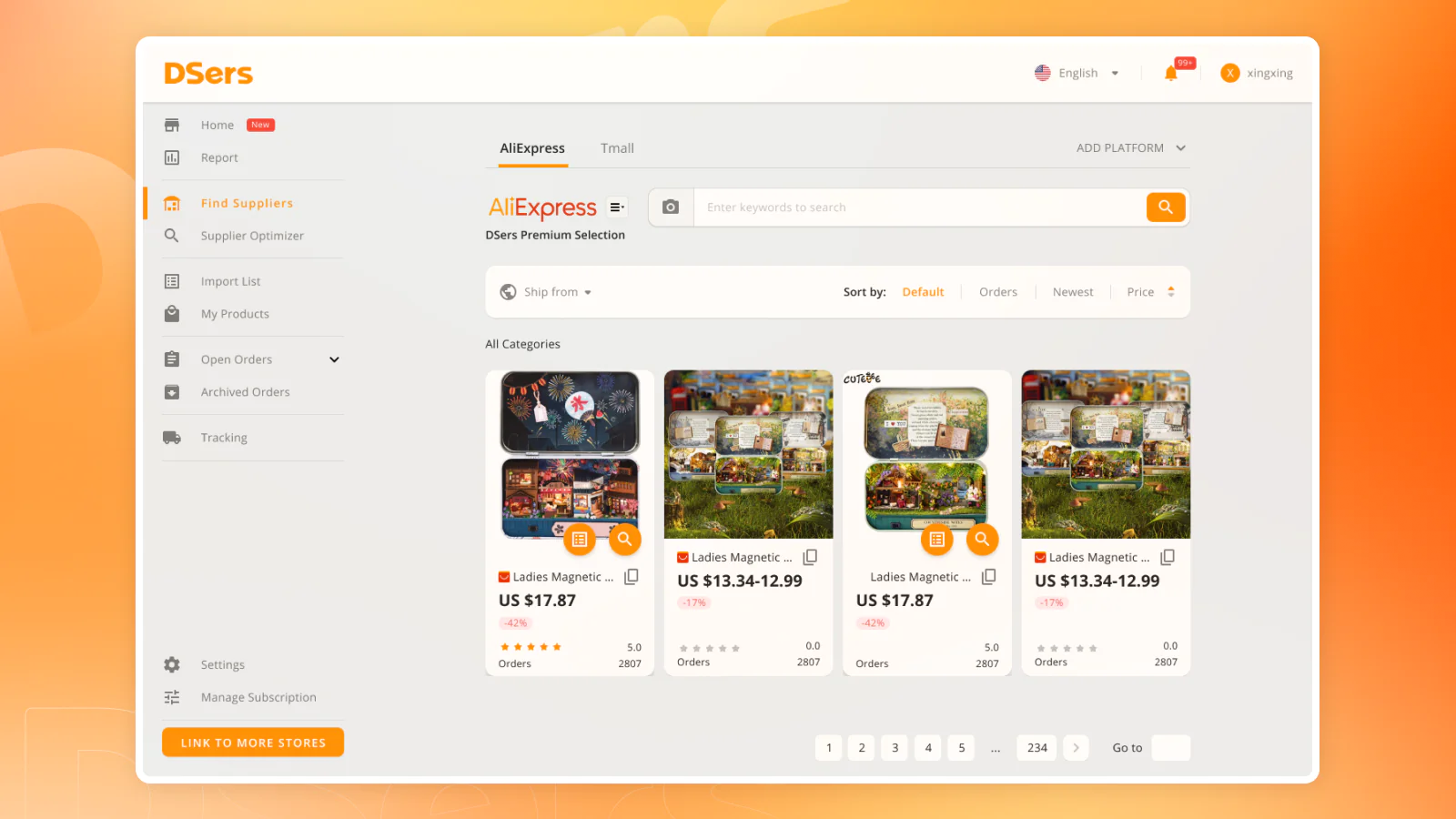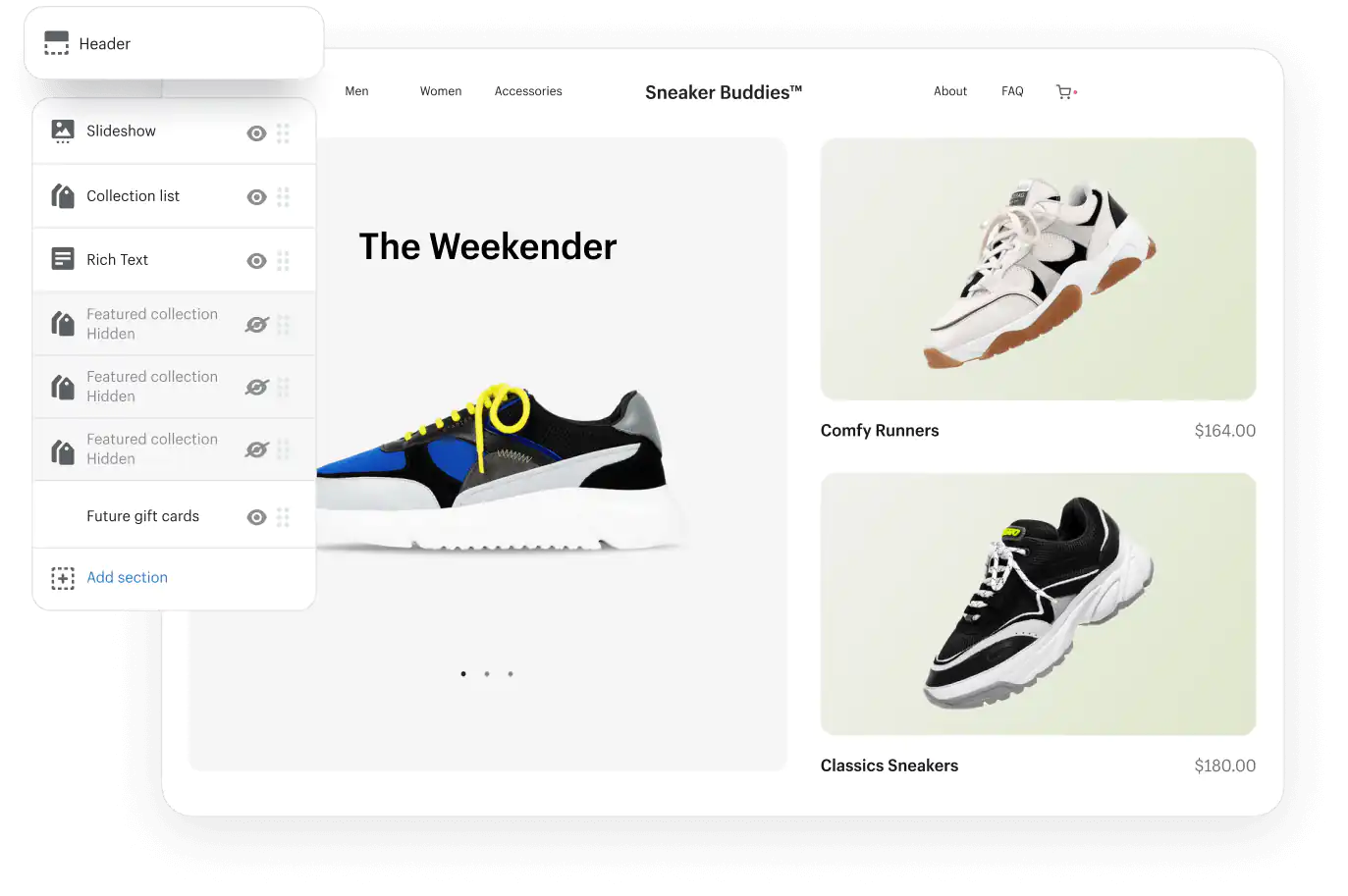Starting a dropshipping business is an accessible path to entrepreneurship. When a customer orders from your dropshipping store, the supplier ships the product directly, so you don’t need to hold inventory and overhead costs stay low.
Follow these nine steps to get your dropshipping business off the ground.
How to start a dropshipping business
- Decide if dropshipping is the right business model
- Choose a dropshipping niche
- Research competitors
- Choose a supplier
- Select products and set prices
- Build an ecommerce store
- Decide on a business structure
- Set up finances
- Market your dropshipping business
Related: How to Dropship on Shopify (2024)
Discover three easy ways to start dropshipping on Shopify, each suited to different experience levels and business goals.
Read more
1. Decide if dropshipping is the right business model
Dropshipping is just one way to run an online store. Before diving in, take time to ensure it’s the right business model for your goals.
Typically, dropshipping is suited to people with marketing skills who want to run a store with minimal upfront investment. Since you don’t need to stock or handle products, it’s possible to start with just a laptop and an internet connection.
However, this accessibility comes with tradeoffs. Dropshippers tend to have less control over the goods in their catalog, and because other retailers are likely to sell the same products, competition can be tough.
If you plan to focus on marketing and aren’t looking to build your business around a flagship product, then dropshipping could work for you.
2. Choose a dropshipping niche
A niche is a segment of a market. You can target a niche with your store, brand, and product selection.
Selecting a dropshipping niche helps you identify a target audience. With specific customers in mind, it’s easier to search for products to dropship.
There are two general methods for selecting a business niche:
- Choose a niche that you’re knowledgeable or passionate about.
- Choose a niche based on market demand.
The aim of the second method is to find niches with high customer interest but low competition. Dropshippers assess market demand through keyword and product research.
Finding a niche with keyword research
Keyword research shows you what people are searching for online. Tools like Google Trends, Facebook Audience Insights, and Keywords Everywhere reveal popular product-related searches that your online store might serve.
When assessing search demand, look at historic interest as well as search volume to find a niche with sustained or increasing popularity.

Interest in “ebikes” over five years. Google Trends
For example, eBike Generation founder John Murphy used keyword research to build a $3 million dropshipping company, by identifying an underserved niche: ebikes for hunters.
Finding a niche with product research
Product research helps you discover trending products and understand consumer tastes for different product categories.
Dropshipping apps like DSers let you see product order volume on marketplaces such as AliExpress to gauge the potential size of your business.
Use both types of research together to build a full picture of a dropshipping niche. Consumer habits change rapidly, so perform regular check-ins on keyword trends and product popularity.
To align your business with product availability, you could also decide to choose your dropshipping supplier before you select a niche.
3. Research competitors
Competitor analysis helps when starting a dropshipping business. Spend time gathering information about rival stores in your niche.
By observing what your competitors, especially other dropshippers, are offering, you can identify potential products and marketing strategies. Review product pages and social media ads to see what appeals to customers.
Conduct thorough competitor research with these tasks:
- Run a Google search
- Use competitor analysis tools
- Browse social media
- Check marketplaces
Run a Google search
Start by searching for keywords relevant to your niche to see which businesses appear. For example, if you’re starting a dropshipping business in the pet supplies niche, you might search for “pet toys,” “pet food,” or “pet brushes.”
Look closely to see which businesses consistently show up in the search results. These are likely your main competitors for organic search audiences. For more in-depth insights, try an SEO tool.
You may find top-ranked competitors optimize their content for long-tail keywords, which are longer, more specific phrases that customers are searching for.
Long-tail keywords have less competition, making them a strategic target for smaller dropshipping websites.
For example, your competitor analysis might reveal the keyword “dog collars” is contested by large retailers, while “LED dog collars” has less competition—and “LED dog collars for small dogs” has room for your new business.
Use competitor analysis tools
Competitor analysis tools are another way to find insights into rivals’ strategies. Uncover data by monitoring traffic sources, visitor counts, and social media engagement.
For instance, if you find a competitor relies heavily on paid ads, you could consider a rival campaign, or invest more in SEO content. If they’re active on a social platform you’ve overlooked, starting a channel might be beneficial.
Browse social media
Follow competitors’ social media pages to understand how they engage with followers. Pay attention to the types of posts that generate the most likes, comments, and shares.
For example, if a competitor in your pet supplies niche is going viral with DIY grooming videos, consider creating similar content. Also, watch for any gaps—perhaps there’s underserved demand for content on pet wellness tips.
Check marketplaces
Sellers within your niche on marketplace platforms like eBay, Amazon, and Etsy also offer insights.
Note how many listings exist for similar products. If the market looks saturated, consider how you might differentiate your product listings, either by reducing your prices or offering a premium customer experience that’s not possible through a marketplace.
Track all your competitor research in a spreadsheet to make it easy to search and reference your findings.
4. Choose a supplier
A dropshipping supplier sources and manages inventory, accepts orders and payments, and organizes shipping to customer addresses.
With such core responsibilities, your choice of supplier will have a large impact on the success of your dropshipping business.
Depending on your niche and the products you sell, you might work with a single supplier, or partner with multiple suppliers using a supplier directory.
Popular supplier directory apps and websites automatically connect your store with a large network of dropshipping suppliers.
For example, the DSers app lets Shopify users dropship products from AliExpress, the global marketplace.

DSers
5. Select products and set prices
The products in your store are dictated by your supplier’s inventory. You’ll encounter many of the same products in rival dropshipping stores, so it’s important to curate a selection that resonates with your niche audience.
A well-chosen product catalog creates opportunities for cross-selling and upselling, where shoppers add additional or higher-priced items to their shopping carts.
When picking products from an app or marketplace, study reviews from other sellers, as well as the supplier’s performance history. Once you have a shortlist, order product samples to assess quality and consistency.
If your strategy includes partnering with overseas suppliers, consider choosing products eligible for expedited mailing services such as ePacket shipping from China. This can significantly cut down delivery times.
Pricing your dropshipping products
Whether it’s electronics, clothing, or toys, you will need a pricing strategy that keeps your dropshipping business sustainable and allows you to make a profit from each sale.
No matter the price point, set a profit margin for every product by calculating your costs, including the price paid to the supplier and other operating expenses. Balance this against the price of similar products in the market to ensure your store is competitive.
6. Build an ecommerce store

Your online store is a hub for your dropshipping business, showcasing your product catalog and giving customers a way to check out. It’s also the destination for traffic from your social media ads.
Beyond product pages, your store can feature content to enhance the customer experience. This includes product reviews, user guides, buying guides, and relevant blog posts. Additional content not only helps customers make decisions, but also improves store visibility in search engine results.
Shopify’s store builder comes with the internet’s best-converting checkout and flexible design options. Customize your store’s appearance with professionally designed themes that fit your brand.
Adding a dropshipping app to your Shopify store simplifies product management and order processing. Popular apps include:
- DSers, for syncing with AliExpress.
- Zendrop, featuring more than a million products.
- Spocket, with suppliers from the US, Europe, Brazil, and India.
Use AI to enhance product pages
AI is built into every Shopify store to help you manage products and sell more effectively. Use AI to enhance product listings with content that goes beyond the basic information provided by your supplier.
Share a few keywords with Shopify Magic to generate product descriptions that outshine competitors, with SEO-friendly language that’s suited to your target audience.
Transform the product photos you receive from a supplier into distinctive, branded images with unique backgrounds, through AI-enhanced image editing. Original visuals differentiate your product pages from competitors.
Click the stars icon whenever it appears in the Shopify Admin to harness the power of Shopify Magic for your dropshipping store.
Dropshipping with Shopify Collective
Connect with US-based Shopify brands to easily sell their products. Use Shopify Collective to curate items from like-minded stores and ship them directly to your customers.
Explore Shopify Collective
7. Decide on a business structure
Writing a business plan and creating a legal entity are key initial steps in setting up your dropshipping business for the long term.
Three common business structures for a dropshipping business are:
- Sole proprietorship
- Limited liability company
- C corporation
Sole proprietorship
A sole proprietorship is run by one person and doesn’t require complex paperwork or additional tax filings. This makes it a popular business structure for dropshippers who want to keep things simple and affordable.
However, sole proprietorships offer no protection of personal assets if the business runs into legal trouble.
Limited liability company (LLC)
Setting up a dropshipping business as a limited liability company keeps personal finances separate from the business, which is not only safer but also makes accounting clear.
Compared to a sole proprietorship, LLCs offer flexible tax benefits, which might help you save money. But you’ll need to comply with additional filing requirements and pay incorporation fees.
C corporation
Many large businesses are set up as C corporations due to the extensive liability protection. C corps are often expensive to incorporate and are subject to double taxation, as income doesn’t pass directly to the shareholders.
Before choosing a business structure, it’s advisable to consult with a lawyer to understand the best fit for your situation.
Apply for an EIN
Most US businesses need an employer identification number (EIN), serving as a Social Security number for your business. An EIN is necessary for filing taxes, applying for wholesale dropshipping accounts, opening a bank account, and other business activities.
Apply for a free EIN online through the IRS.
8. Set up finances
Separating your personal banking from your dropshipping business helps simplify accounting and keeps your business’s financial health visible.
Consider these basic financial tasks:
Open a business checking account
Open a business bank account to deposit revenue. A dedicated account for your dropshipping store makes tracking income and expenses easier and ensures financial transparency.
Apply for a business credit card
Consider getting a business credit card to pay for product orders, software subscriptions, ad fees, and other expenses. This helps keep your personal and business expenses separate and can also earn you rewards if you choose a card with benefits.
Check local business license requirements
Even if you operate from home, your city might require a business license. The requirements can vary, so checking with your local government is essential to ensure you comply with all local laws.
Collect sales tax
Collect sales tax if your business operates in a state that requires it. You generally don’t need to collect sales tax for orders outside your state, though it’s prudent to stay updated on the latest rules.
If your state does charge sales tax, be prepared to collect taxes from eligible customers.
Manage sales tax from Shopify
Shopify Tax puts sales tax insights and collection in your control and makes everything manageable from your Shopify admin.
Explore Shopify Tax
9. Market your dropshipping business
Once your dropshipping store is live, turn your attention to marketing. An active marketing strategy that brings traffic to your store will give your dropshipping business the best chance of success.
Develop a strategy for these marketing channels:
- Paid ads
- Influencer marketing
- Content marketing
- Communities
- Mobile marketing
- Email marketing
Paid ads
Experiment with ads on Facebook, Instagram, TikTok, YouTube, and Google. Social media ads help increase your brand’s reputation among related audiences, while Google Ads target consumers with specific buying intentions.
Testing ads on both platforms can help you determine the most effective approach.
Influencer marketing
Collaborating with influencers on platforms like TikTok and Instagram can help extend your reach and credibility, potentially leading to increased sales.
Use Shopify Collabs to connect with influencers in your niche and pay them using a performance-based affiliate marketing model.
Content marketing
Developing a content marketing strategy can enhance your brand’s visibility. Consider starting a blog, making instructional videos, or launching a podcast related to your niche. Good content can keep customers engaged post purchase.
Communities
Get involved with groups of people who are passionate about your niche. Participating in discussions on platforms like Reddit and Facebook Groups can build trust and foster relationships—as long as you’re not overly sales-focused.
Mobile marketing
If you can generate a list of subscribers, SMS (text message) marketing strategies tend to receive high engagement levels. Consider creating a VIP group chat, offering live chat support, or sending messages with limited-time promo codes.
Email marketing
Email marketing helps maintain relationships with customers after they exit your website. Sending personalized emails with promotions and useful information can encourage repeat business.
Dropshipping mistakes to avoid
Like any retail business, running a dropshipping store comes with challenges. Avoid these common dropshipping pitfalls to keep your business growing:
Ignoring sales data
A common error among new dropshippers is not paying close attention to what their sales data is telling them.
Continually monitor sales, and don’t be afraid to pivot your store to optimize for profit. Regularly check:
- Which products are selling well and which aren’t.
- How much money you’re making from ads.
- Which products are giving you the best profit.
- How trends in sales are changing over time.
- Where your customers are coming from and what devices they use.
Skipping SEO
Whether your customers find you via Google or social media, your online visibility is crucial, as it directly influences traffic and sales.
As a result, not working on your website’s search engine optimization can limit your growth. Be sure to focus on:
- Creating original, helpful content for product pages.
- Improving your website’s loading speed.
- Making your website easy to use on mobile devices.
Shopify stores come with fast loading and responsive page design. Use Google Search Console to see how your website performs and find areas for improvement.
Not planning for growth
Not preparing to grow can bottleneck your business. Build your store to accommodate next year’s order volume, not today’s. Avoid limitations such as:
- Relying on one supplier. Always look for alternatives to mitigate risks and keep products in stock.
- Manually handling orders. Use a dropshipping app that automates order processing.
A benefit of dropshipping is the ability to accept increasingly large order volumes without significant investment. Have the systems in place to handle more orders when they arrive.
Neglecting unhappy customers
While dropshippers don’t deal with inventory directly, they are the primary touchpoint for customer support. Failing to focus on customers, especially those with complaints, can lead to negative reviews and high return rates.
To enhance your customer experience:
- Create accurate product descriptions
- Provide clear contact information
- Respond to every customer question and concern
- Manage returns and refunds quickly, before reaching out to the supplier
The latest customer service AI tools and chatbots give you the power to answer customers immediately.
Start your dropshipping business in 2024
Starting a dropshipping business has never been easier. Whether you’re a side hustler, an entrepreneur, or looking to expand your existing store, Shopify makes dropshipping efficient and low-cost.
Start your free trial today and connect a popular dropshipping app or sell products from known brands with Shopify Collective.
How to start dropshipping FAQ
How do I start a dropshipping business?
- Identify a niche: Select a specific market to target.
- Research competitors: Analyze what businesses in your niche are successful and why.
- Choose a dropshipping supplier: Partner with a reliable supplier that stocks products you want to sell.
- Create an online store: Design and build an ecommerce website to showcase your products.
- Market your business: Use social media ads and engaging content to attract customers.
How do I find the best products for dropshipping?
To identify the best products for your dropshipping business, start by choosing a niche with high demand but low competition. Research trends and customer interests using tools like Google Trends, and analyze market data to determine profitable products.
Is dropshipping really profitable?
Dropshipping can be a profitable business because sellers are not responsible for shipping or manufacturing. There are many dropshippers who earn more than $100,000 per year. However, because of the accessibility of starting a dropshipping business, competition among dropshippers is often fierce, limiting potential profit margins.




